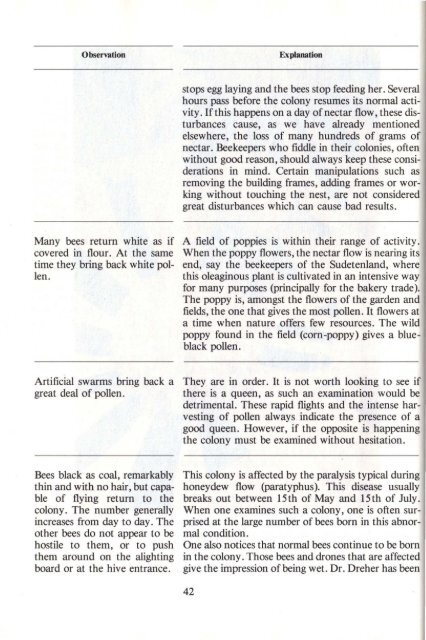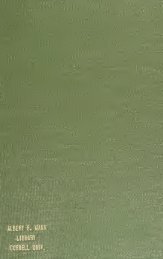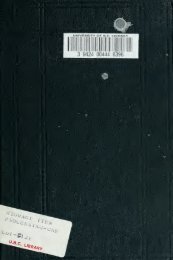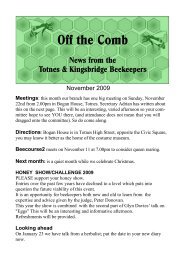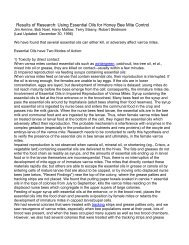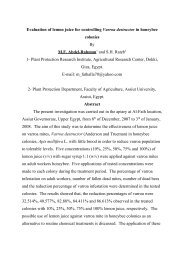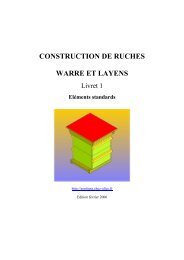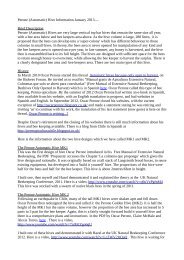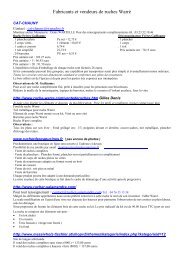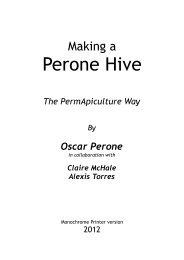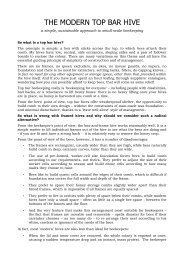Create successful ePaper yourself
Turn your PDF publications into a flip-book with our unique Google optimized e-Paper software.
Observation<br />
Explanation<br />
stops egg laying and <strong>the</strong> bees stop feeding her. Several<br />
hours pass before <strong>the</strong> colony resumes its normal activity.<br />
If this happens on a day of nectar flow, <strong>the</strong>se disturbances<br />
cause, as we have already mentioned<br />
elsewhere, <strong>the</strong> loss of many hundreds of grams of<br />
nectar. Beekeepers who fiddle in <strong>the</strong>ir colonies, often<br />
without good reason, should always keep <strong>the</strong>se considerations<br />
in mind. Certain manipulations such as<br />
removing <strong>the</strong> building frames, adding frames or working<br />
without touching <strong>the</strong> nest, are not considered<br />
great disturbances which can cause bad results.<br />
Many bees return white as if<br />
covered in flour. <strong>At</strong> <strong>the</strong> same<br />
time <strong>the</strong>y bring back white pollen.<br />
A field of poppies is within <strong>the</strong>ir range of activity.<br />
When <strong>the</strong> poppy flowers, <strong>the</strong> nectar flow is nearing its<br />
end, say <strong>the</strong> beekeepers of <strong>the</strong> Sudetenland, where<br />
this oleaginous plant is cultivated in an intensive way<br />
for many purposes (principally for <strong>the</strong> bakery trade).<br />
The poppy is, amongst <strong>the</strong> flowers of <strong>the</strong> garden and<br />
fields, <strong>the</strong> one that gives <strong>the</strong> most pollen. It flowers at<br />
a time when nature offers few resources. The wild<br />
poppy found in <strong>the</strong> field (corn-poppy) gives a blueblack<br />
pollen.<br />
Artificial swarms bring back a<br />
great deal of pollen.<br />
They are in order. It is not worth looking to see if<br />
<strong>the</strong>re is a queen, as such an examination would be<br />
detrimental. These rapid flights and <strong>the</strong> intense harvesting<br />
of pollen always indicate <strong>the</strong> presence of a<br />
good queen. However, if <strong>the</strong> opposite is happening<br />
<strong>the</strong> colony must be examined without hesitation.<br />
Bees black as coal, remarkably<br />
thin and with no hair, but capable<br />
of flying return to <strong>the</strong><br />
colony. The number generally<br />
increases from day to day. The<br />
o<strong>the</strong>r bees do not appear to be<br />
hostile to <strong>the</strong>m, or to push<br />
<strong>the</strong>m around on <strong>the</strong> alighting<br />
board or at <strong>the</strong> hive entrance.<br />
This colony is affected by <strong>the</strong> paralysis typical during<br />
honeydew flow (paratyphus). This disease usually<br />
breaks out between 15 th of May and 15 th of July.<br />
When one examines such a colony, one is often surprised<br />
at <strong>the</strong> large number of bees born in this abnormal<br />
condition.<br />
One also notices that normal bees continue to be born<br />
in <strong>the</strong> colony. Those bees and drones that are affected<br />
give <strong>the</strong> impression of being wet. Dr. Dreher has been<br />
42


